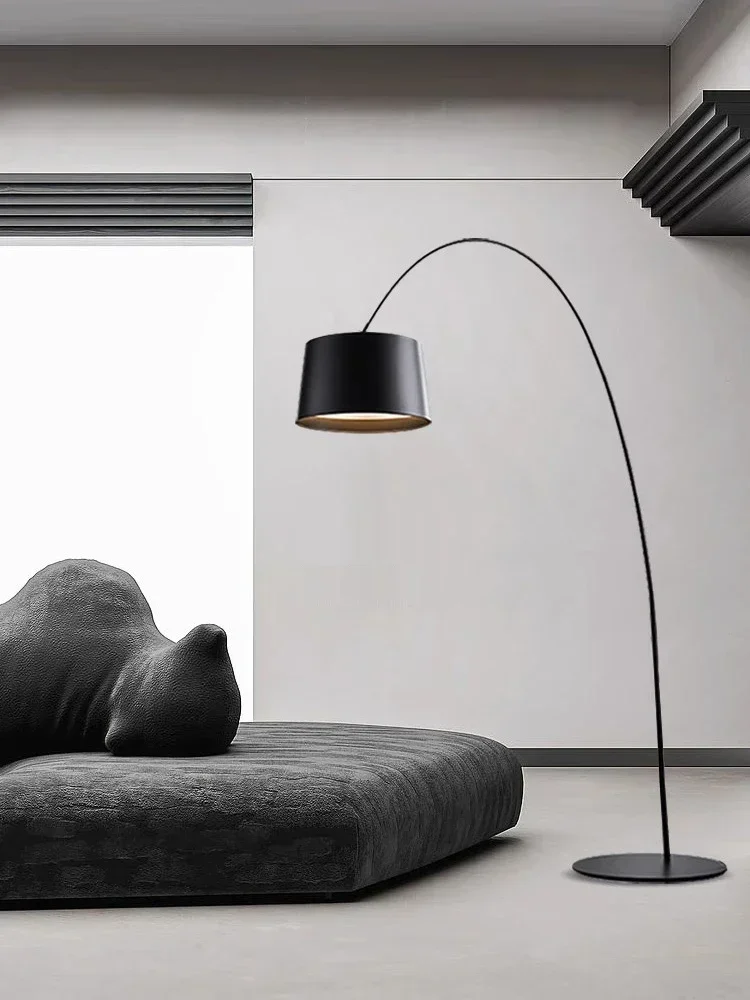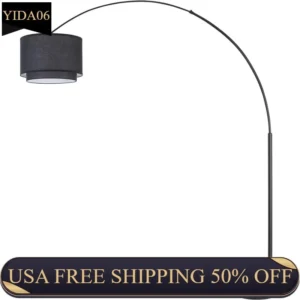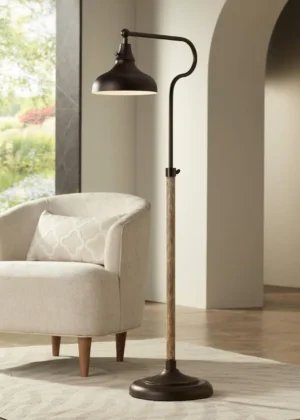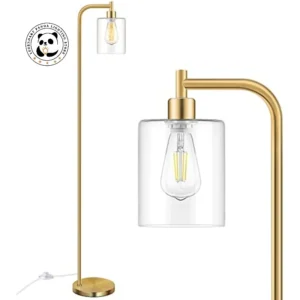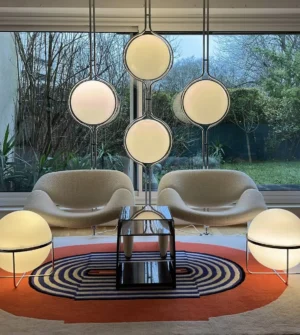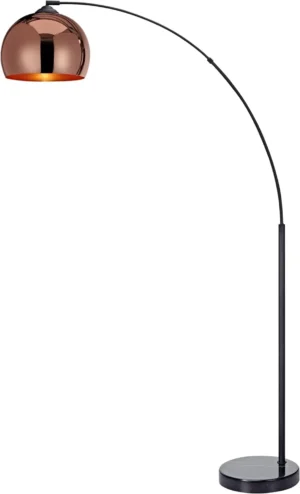Introduction to Arc Lamps: Design and Purpose
Arc floor lamps stand out in the world of interior lighting with their distinctive curved arm design that extends gracefully from the base. Unlike traditional floor lamps that rise straight up, arc lamps feature a dramatic sweep that allows light to be positioned directly over seating areas, dining tables, or other spaces that benefit from overhead illumination.
These elegant lighting fixtures serve both functional and aesthetic purposes in home design. Their architectural silhouette adds a sculptural element to any room, creating visual interest even when the lamp isn’t illuminated. The curved design is based on the engineering principle of a cantilever—a beam supported at only one end while extending outward.
The primary advantages of arc lamps include:
* Providing overhead lighting without ceiling installation or wiring
* Offering flexible positioning that can be adjusted as needed
* Creating a focal point that enhances your interior design scheme
* Maximizing floor space by allowing furniture placement directly beneath the light
What began as purely functional lighting has evolved into statement pieces that can define a room’s style. However, the distinctive arched design creates a unique challenge: balance. Without a properly designed base, these lamps would simply tip over. This fundamental relationship between the graceful arc and its anchoring base forms the core of arc floor lamp base stability, which we’ll explore throughout this guide.
The Physics of Arc Lamp Stability
Understanding arc lamp stability requires a basic grasp of physics—specifically, how balance works in objects with extended, uneven weight distribution. The curved arm of an arc lamp creates what engineers call a “moment arm” or leverage effect. The further the lamp head extends from the vertical support, the greater the tipping force becomes.
The center of gravity in an arc lamp is not centered over the base like in traditional floor lamps. Instead, it shifts toward the extended lamp head, creating a natural tendency to tip in that direction. This is why the counterweight principle is essential: the base must be heavy enough to offset this imbalance.
A simple way to understand this is to imagine a seesaw. If a small child sits at one end, you need a heavier weight at the shorter end to maintain balance. In arc lamps, the base represents that heavier counterweight that keeps the extended arm from causing the lamp to topple.
The relationship between the lamp’s height, reach (how far it extends horizontally), and required base weight follows a proportional pattern. As a general rule, many designers use a 3:1 ratio—the base should weigh approximately three times what the extended arm and lamp head weigh together. This is why you’ll notice that larger arc lamps invariably feature substantially heavier bases.
The footprint size—how much floor space the base occupies—also plays a crucial role. A wider base creates more stability by distributing weight over a larger area, making it harder for the lamp to tip. This physics-based approach to how to stabilize arc floor lamp bases explains why these lighting fixtures require such distinctive base designs.
Essential Role of the Base in Arc Lamp Design
The base of an arc lamp isn’t merely a decorative element—it’s the foundation that makes the entire design possible. Without a properly weighted base, an arc lamp would be both dangerous and essentially useless, constantly tipping over at the slightest touch or breeze.
The key functions of an arc lamp base include:
- Providing the counterweight necessary to offset the extended arm
- Creating a stable foundation that prevents tipping during normal use
- Ensuring the lamp remains steady when adjustments are made
- Contributing to the overall aesthetic appeal and design statement
- Protecting flooring from damage (with proper materials and padding)
The longer and higher the arc extends, the heavier the base must be to maintain stability. This relationship can’t be circumvented without compromising safety. Even the most beautiful arc lamp design will fail if its base cannot adequately counterbalance the extended arm.
What makes arc lamp design particularly fascinating is how designers have transformed this fundamental requirement into an opportunity for creative expression. Rather than hiding the necessarily heavy base, many designers celebrate it as a focal point of the lamp’s aesthetic, using luxurious materials and distinctive shapes that enhance the overall design while serving their essential stabilizing function. The stable base designs for arc floor lamps show remarkable creativity while adhering to these fundamental principles.
Marble Bases: Luxury and Functionality Combined
Marble bases represent the perfect marriage of form and function in arc lamp design. Their natural heft provides the necessary counterweight while their luxurious appearance elevates the lamp to a statement piece. This material has been favored by designers for decades, most notably in the iconic Arco lamp which helped establish marble as the premium choice for arc lamp bases.
Key characteristics of marble bases include:
- Exceptional natural weight (typically 40-70 pounds/18-32 kg) providing superior stability
- Heat resistance, preventing damage from accidental contact with hot items
- Remarkable durability that allows the lamp to last for generations
- Unique veining patterns ensuring no two bases are exactly alike
- Cool-to-the-touch surface that contrasts with the warmth of the light
Common marble varieties used in arc lamp bases include Carrara (white with subtle gray veining), Calacatta (more dramatic white with bold veining), and Nero Marquina (black with striking white veins). Each offers distinctive visual characteristics while providing the necessary weight.
The shape of marble bases varies with design intent. Round bases offer a softer look with no sharp corners, making them safer in high-traffic areas. Square and rectangular bases provide a more architectural statement and often more stability due to their wider footprint. Some designs feature beveled or chamfered edges to soften the visual weight while maintaining physical mass.
Maintenance requirements for marble bases are relatively simple—regular dusting and occasional cleaning with a stone-safe cleaner are typically all that’s needed. However, their weight does present challenges when moving or repositioning the lamp.
For those drawn to the timeless elegance of natural stone, our collection of marble base arc floor lamps offers various interpretations of this classic design approach.
Metal Bases: Versatility and Modern Appeal
Metal bases offer tremendous versatility in arc lamp design, allowing for everything from slim, minimalist profiles to substantial, statement-making foundations. The choice of metal significantly impacts both the lamp’s stability and its aesthetic appeal.
Different metals bring distinct properties to arc lamp bases:
| Metal Type | Weight Properties | Typical Finishes | Design Style |
|---|---|---|---|
| Cast Iron | Heaviest option, excellent stability | Powder-coated, painted | Industrial, traditional |
| Steel | Very sturdy, good weight-to-size ratio | Brushed, polished, chrome, painted | Contemporary, versatile |
| Brass | Moderate weight, often requires wider footprint | Polished, antique, brushed | Mid-century, luxury |
| Aluminum | Lightest option, often needs additional weighting | Anodized, painted, brushed | Modern, minimalist |
Steel represents perhaps the most common choice for contemporary arc lamp bases due to its excellent balance of weight, durability, and finish options. Hollow steel bases often contain internal weights (like concrete or sand) to achieve necessary stability while maintaining a sleek exterior appearance.
The finish of metal bases dramatically affects their visual impact. Polished chrome creates a reflective, contemporary look, while brushed nickel offers a more subtle sheen. Matte black finishes have gained tremendous popularity for their ability to complement almost any interior style. Brass finishes, especially in warm tones, connect to mid-century modern aesthetics that remain highly sought after.
Metal bases also allow for more complex shapes and design elements than stone. Some feature cutout patterns, perforations, or sculptural elements that would be impossible in marble or concrete. Others incorporate storage functions, like magazine racks or small shelves, adding practical utility.
For spaces that demand a more industrial or contemporary aesthetic, our selection of metal finish arc floor lamps offers numerous options that balance modern design with proper stability.
Concrete Bases: Industrial Strength and Contemporary Style
Concrete bases have emerged as a popular choice for arc lamps, particularly in contemporary, industrial, and minimalist interior designs. Like marble, concrete offers substantial weight, providing excellent stability for even the most dramatically arched lamps, but with a distinctly modern aesthetic.
Key advantages of concrete bases include:
- Extreme density and weight in a relatively compact form
- Industrial aesthetic that pairs well with modern interiors
- Customizable finishes from rough and textured to highly polished
- Potential for colored concrete or embedded materials for visual interest
- Lower cost compared to premium marble options
The industrial character of concrete makes these bases particularly well-suited to loft spaces, minimalist designs, and interiors with exposed architectural elements like brick walls or steel beams. The raw, honest nature of the material creates a compelling contrast with the often delicate, arching lamp arm.
Concrete bases typically feature simple geometric shapes—most commonly circles or squares with clean edges. However, modern casting techniques allow for more complex forms, including tapered designs, rounded edges, or even sculptural elements molded directly into the base.
Finish options range widely, from roughly textured surfaces that showcase the aggregate within the concrete to highly polished finishes that can resemble natural stone. Some designers even incorporate other materials into the concrete mix, such as glass fragments or metal filings, to create unique visual textures.
Maintenance for concrete bases is straightforward, though unfinished concrete may be somewhat porous and benefit from sealing to prevent staining. The substantial weight of concrete makes these bases extremely stable but also somewhat challenging to move, a consideration for those who frequently rearrange their furniture.
For those seeking industrial chic appeal combined with rock-solid stability, specialized weighted bases for arc lamps offer contemporary solutions that balance form with function.
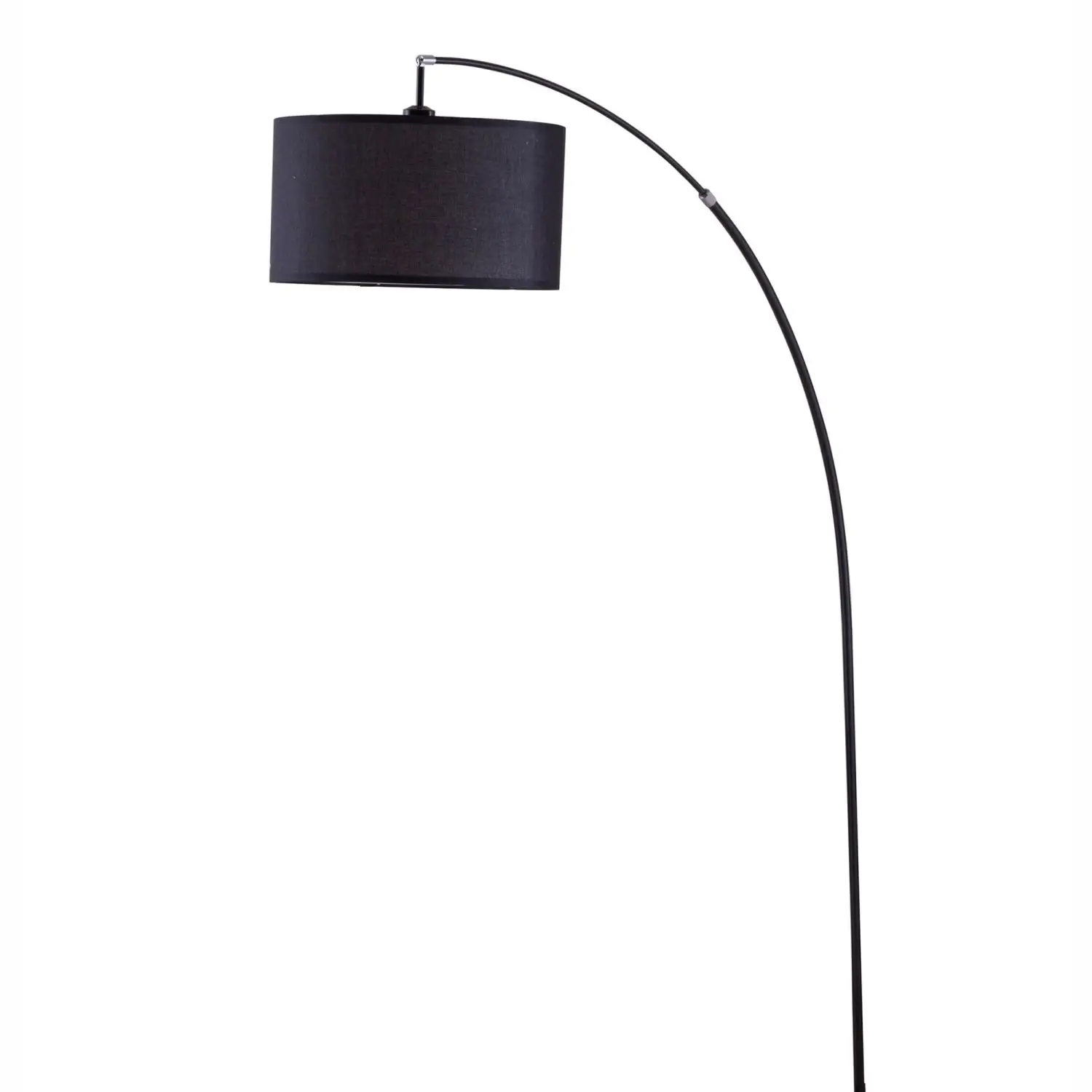
Alternative Base Materials: Wood, Stone Composites, and Glass
While marble, metal, and concrete dominate the arc lamp base market, several alternative materials offer unique aesthetic qualities and practical advantages. These less conventional options often require clever engineering to overcome weight limitations while maintaining the stability essential to arc lamp functionality.
Wood bases bring natural warmth and organic texture to arc lamp designs. However, since wood weighs significantly less than stone or metal, designers must employ creative solutions to achieve necessary stability:
- Increasing the footprint size to distribute weight more effectively
- Using exceptionally dense hardwoods like oak or walnut
- Incorporating hidden metal plates or concrete cores within wooden shells
- Designing wider, lower profiles that naturally resist tipping
Stone composites, including terrazzo, engineered stone, and resin-bonded materials, offer another interesting alternative. These materials can mimic the appearance of natural stone while potentially reducing weight or cost. Some composites also allow for color options and pattern variations not found in natural materials.
Glass bases represent perhaps the most visually striking option. Clear or colored glass creates a sense of lightness despite the actual weight of the material. Glass bases typically feature thick, heavy construction, often with substantial diameter to compensate for glass’s lower density compared to marble. The visual effect is particularly dramatic with illuminated bases that incorporate secondary light sources.
Mixed-material bases combine the benefits of different components—for example, a metal frame with concrete filling, or a wooden base with a marble inset. These hybrid approaches can achieve both the necessary weight and desired aesthetic while sometimes offering cost advantages.
For those drawn to the warm, natural appeal of timber elements, our collection of wood arc floor lamps showcases how this traditional material can be reimagined for contemporary lighting design.
Selecting the Ideal Arc Lamp Base for Your Space
Choosing the right arc lamp base requires careful consideration of both practical requirements and design preferences. The perfect arc lamp for your space should balance stability needs with aesthetic harmony while fitting comfortably within your available area.
When selecting an arc lamp base, consider these essential factors:
Room dimensions: Larger rooms can accommodate more substantial bases, while smaller spaces may require compact designs that slide partially under furniture.
Floor surface: Carpet requires wider, heavier bases to compensate for the less stable surface. Hardwood or tile floors benefit from bases with protective padding to prevent scratches.
Placement needs: Will the lamp stand freely in the room, or does the base need to slide under a sofa or table? Free-standing lamps offer more base options, while furniture-adjacent placement often requires slimmer profile bases.
Design compatibility: Consider your existing interior elements. Marble bases complement traditional and luxury interiors, metal suits contemporary and industrial spaces, while concrete works well in minimalist settings.
Lamp proportions: Taller lamps with longer reaches require proportionally heavier bases. As a general guideline, the arc height should be at least 7 feet (2.1 m) for placement over seating areas, with the base weight increasing accordingly.
Maintenance preferences: Consider how much care you’re willing to provide. Marble may require occasional sealing, metals need polishing or dusting, and concrete might need protection from acidic spills.
Before purchasing, measure your space carefully. Allow at least 12-18 inches (30-45 cm) of clearance around the base for visual breathing room, and ensure the arc has sufficient height for its intended placement. Remember that the base will need to sit on a level surface to ensure proper balance and stability.
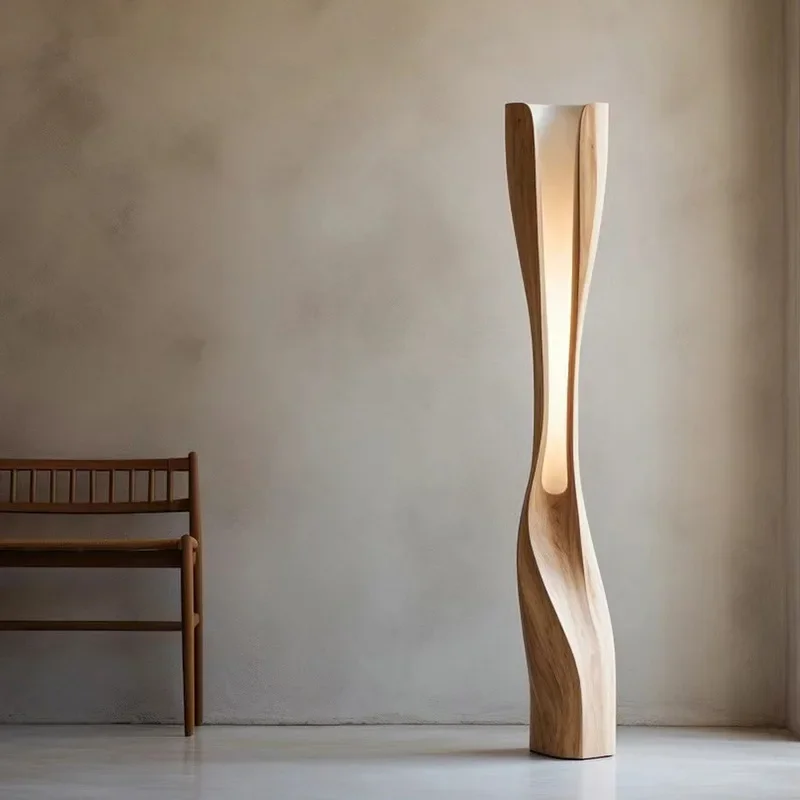
Enhancing Arc Lamp Stability: Troubleshooting and Solutions
Even with a well-designed base, certain situations may require additional measures to ensure your arc lamp remains perfectly stable. Recognizing the signs of instability and knowing how to address them can significantly extend your lamp’s lifespan while improving safety.
Signs that your arc lamp may need stability enhancement include:
- Wobbling or rocking when lightly touched
- Gradual tilting in the direction of the arc
- Base lifting slightly off the floor on one side
- Lamp head drooping lower over time
- Difficulty keeping the arm in your desired position
For lamps with insufficient base weight, several effective solutions exist:
- Commercial lamp weights: Purpose-made weights designed to sit atop the base, often disguised as decorative elements
- DIY weight additions: Filling hollow metal bases with sand or lead shot to increase mass
- Weighted discs: Flat, heavy discs that slide under existing bases to increase stability
- Floor anchors: In extreme cases, specially designed brackets can secure the lamp to the floor
Proper placement also significantly affects stability. Position arc lamps away from high-traffic areas, doorways, or places where they might be bumped by people or pets. On carpeted floors, consider using a small, firm board under the base to create a more stable foundation.
For maximum stability, regular maintenance checks are essential:
- Inspect all connections and tightening mechanisms monthly
- Check that the base remains completely level
- Ensure any weight additions remain properly positioned
- Verify that protective padding on the base remains intact
- Test the overall stability with a gentle pressure test
Implementing these strategies can dramatically improve the stability of your arc lamp. For comprehensive approaches to preventing arc lamps from tipping, proper base selection combined with strategic placement and occasional maintenance provides the best long-term solution.
Safety Considerations: Preventing Accidents with Arc Lamps
Arc lamps, with their extended reach and cantilevered design, require special attention to safety considerations. Taking proactive measures can prevent accidents and ensure these statement pieces enhance your space without creating hazards.
Important safety guidelines for arc lamp ownership include:
Placement planning: Position lamps away from walkways and areas where people might bump into them. Allow at least 24 inches (61 cm) of clearance around the lamp head.
Stability verification: Before placing an arc lamp in its final position, test its stability by gently pushing the base in different directions. It should remain firmly planted.
Child and pet considerations: In homes with young children or active pets, select lamps with exceptionally stable bases or consider wall-anchoring options for additional security.
Cable management: Route the power cord away from traffic paths to prevent tripping hazards. Consider cord covers or strategic furniture placement to conceal cords.
Regular inspections: Check all connections periodically, especially weight-bearing joints where the arm connects to the base and where sections of the arm connect to each other.
Floor protection: Ensure the base has appropriate padding to prevent damage to flooring and to increase friction between the base and floor.
When purchasing an arc lamp, look for safety certifications like UL (Underwriters Laboratories) or ETL (Electrical Testing Laboratories) that indicate compliance with safety standards. These certifications ensure the lamp meets minimum requirements for electrical safety and stability.
If you notice your existing floor lamp beginning to lean or become unstable, address the issue immediately. Understanding how to keep floor lamps from leaning can prevent potentially dangerous situations and extend the functional life of your lighting fixture.
Contemporary Arc Floor Lamp, Large Arc Floor Lamp, Oversized Arched Floor Lamp
$460.63 Select options This product has multiple variants. The options may be chosen on the product pageAdjustable Arc Floor Lamp, Bronze Arc Floor Lamp
Price range: $440.95 through $558.52 Select options This product has multiple variants. The options may be chosen on the product pageBrass Arc Floor Lamp, Contemporary Arc Floor Lamp, LED Arc Floor Lamp
Price range: $490.72 through $522.04 Select options This product has multiple variants. The options may be chosen on the product pageChrome Arc Floor Lamp, LED Arc Floor Lamp
Price range: $304.95 through $1,210.40 Select options This product has multiple variants. The options may be chosen on the product pageContemporary Arc Floor Lamp, Large Arc Floor Lamp, Marble Base Arc Floor Lamp
$224.94 Select options This product has multiple variants. The options may be chosen on the product pageMid-Century Arc Floor Lamp, Wood Arc Floor Lamp
$230.86 Select options This product has multiple variants. The options may be chosen on the product page
Iconic Arc Lamps and Their Base Designs
The history of arc lamp design features several groundbreaking models that have influenced generations of lighting designers. These iconic pieces demonstrate how thoughtful base design solves practical problems while creating enduring aesthetic appeal.
The Arco lamp, designed by Achille and Pier Giacomo Castiglioni in 1962, remains perhaps the most influential arc lamp ever created. Its distinctive Carrara marble base—a rectangular block with rounded corners weighing approximately 65 pounds (29.5 kg)—perfectly counterbalances the dramatic 8-foot (2.4 m) arc. The designers cleverly included a hole through the marble base to allow a broomstick to be inserted, enabling two people to carry the heavy base more easily. This practical detail exemplifies how even the most elegant designs can incorporate thoughtful functionality.
Contemporary designers have continued to innovate with base designs that solve the balance equation in new ways. Some notable approaches include:
- Multi-point bases that distribute weight across a wider footprint while maintaining a visually light appearance
- Adjustable counterweight systems that allow the base weight to shift as the arc position changes
- Integrated furniture bases where the lamp base doubles as a side table or shelf
- Sculptural forms that transform the necessary weight into an artistic statement
The evolution of arc lamp bases demonstrates how designers have embraced the physics challenge as a creative opportunity rather than a limitation. For spaces with high ceilings, specialized arc lamps designed for tall ceilings often feature particularly innovative base solutions to support their extended reach.
Maintenance and Care for Different Arc Lamp Bases
Proper maintenance of your arc lamp base not only preserves its appearance but also ensures its continued stability and functionality. Different materials require specific care approaches to maintain their integrity and beauty.
For marble bases:
* Dust regularly with a soft, dry cloth
* Clean spills immediately to prevent staining
* Apply a stone-specific cleaner every few months
* Consider sealing the marble annually to protect against stains
* Use coasters under drinks if the base doubles as a side table
* Avoid acidic cleaners that can etch the surface
For metal bases:
* Remove dust with a microfiber cloth
* Clean chrome, brass, or stainless steel with appropriate metal polish
* Apply a thin coat of paste wax to brushed finishes for protection
* Touch up any chips in painted finishes promptly
* Check occasionally for oxidation or corrosion, especially in humid environments
* Tighten any visible screws or fasteners that may loosen over time
For concrete bases:
* Dust regularly and wipe with a slightly damp cloth when needed
* Apply concrete sealer annually to prevent staining and moisture absorption
* Address any chips promptly with concrete repair compound
* Avoid harsh chemical cleaners that might damage the surface
For wooden bases:
* Dust frequently with a soft cloth
* Apply furniture polish appropriate for the finish type
* Keep away from direct sunlight to prevent fading
* Maintain consistent humidity levels to prevent cracking
* Address scratches with touch-up markers designed for wood furniture
When moving arc lamps with heavy bases, always lift the base rather than dragging it to prevent floor damage. For particularly heavy bases like marble, consider using furniture sliders or getting assistance from another person. Our carefully curated selection of contemporary arc floor lamps includes models with various base materials, each requiring specific care approaches to maintain their beauty.
Frequently Asked Questions About Arc Lamp Bases
How heavy should an arc lamp base be?
The base weight should be proportional to the lamp’s height and reach. As a general rule, the base should weigh 3-4 times the weight of the extended arm and lamp head combined. For typical arc lamps, this means bases weighing 40-70 pounds (18-32 kg). Larger floor lamps with extended reaches may require even heavier bases.
Are arc lamps safe around children and pets?
With proper selection and placement, arc lamps can be safe in homes with children and pets. Choose models with exceptionally stable bases, position them away from play areas and traffic paths, and consider additional stabilizing measures like floor anchors in high-activity households.
Can I put an arc lamp on carpet or uneven surfaces?
Carpeted floors can reduce stability due to their uneven, soft surface. For carpet installation, choose arc lamps with wider, heavier bases, or place a firm board underneath to create a stable foundation. For uneven floors, use adjustable furniture levelers under the base to create a perfectly level surface.
How do I stop my floor lamp from tipping?
To prevent tipping, ensure your lamp has adequate base weight for its size, place it on a level surface away from high-traffic areas, consider adding supplemental weights to the base, and verify all connections are tight. In some cases, wall anchors or floor brackets may provide additional security.
What materials offer the best stability-to-price ratio?
Steel and concrete bases typically offer excellent stability at moderate price points. Marble provides superior stability but at a higher cost. Hollow metal bases filled with sand or concrete can achieve good stability while keeping costs lower than solid stone options.
Can I replace just the base of my arc lamp?
While technically possible in some cases, replacing just the base is challenging due to the specialized connections between base and arm. Some modular lamps are designed with replaceable components, but most arc lamps are integrated units where replacing the base alone is impractical.
How do I move a lamp with a heavy marble base?
For marble bases with holes (like the classic Arco lamp), insert a broomstick through the hole and have two people carry it. For solid bases without holes, use furniture sliders under the base, or place the lamp on a sturdy dolly. Never drag marble bases across floors, as this can damage both the base and flooring.
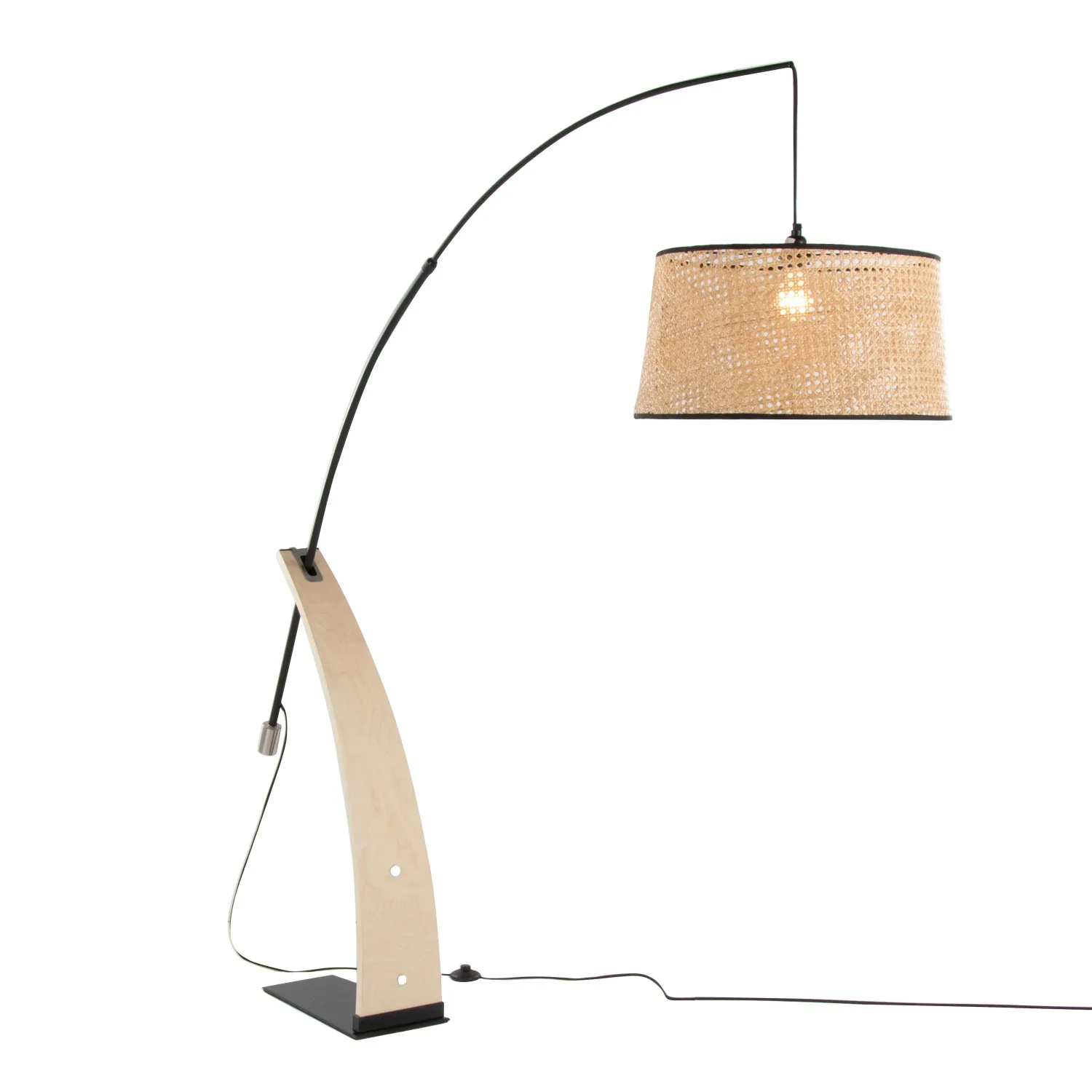
Our comprehensive guide to stabilizing floor lamp bases addresses many common stability concerns and offers additional solutions for specific situations.
Balancing Form and Function: The Art of Arc Lamp Design
Arc lamps represent one of the most elegant solutions to the age-old problem of providing overhead light without ceiling installation. What makes them particularly fascinating from a design perspective is how their most challenging technical requirement—the need for a heavy, stabilizing base—has become their signature aesthetic feature.
Throughout design history, architects and designers have embraced constraints as creative opportunities rather than limitations. The arc lamp perfectly exemplifies this principle. Instead of hiding or minimizing the necessary counterweight, visionary designers have celebrated the base as an integral part of the lamp’s visual identity, using luxurious materials and sculptural forms that draw the eye.
This evolution reflects a broader design philosophy where engineering requirements inspire rather than restrict creative expression. The physics problem of balance has driven designers to explore innovative shapes, materials, and proportions that might never have emerged without this fundamental challenge.
Current trends in arc lamp base design include:
* Multifunctional bases that incorporate storage, display space, or even charging stations
* Environmentally conscious materials like recycled metals and sustainably harvested stone
* Customizable options that allow users to adjust weight distribution as needed
* Mixed material approaches that blend the best properties of different substances
The enduring appeal of arc lamps lies in this perfect marriage of form and function—where the solution to a technical problem becomes the defining characteristic of an iconic design. Our collection of minimalist arc floor lamps demonstrates how contemporary designers continue to find new expressions of this balance between visual elegance and physical stability.
At Interior Ivy, we carefully select each arc lamp for its thoughtful approach to this fundamental design challenge, ensuring our customers receive lighting that’s both beautiful and properly engineered for years of stable, reliable performance.

